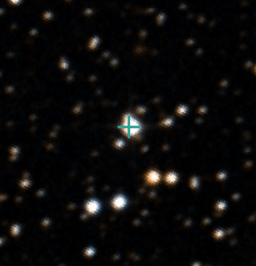Star of the Month
SS Cygni
Position: 21 hrs 42 min 42.8 sec +43 degrees 35 min 10 sec
Due south at 03.08 (BST) on 16 July 2021
SS Cygni
Image: Simbad (http://simbad.u-strasbg.fr/simbad/)
Since it was discovered by Louisa Wells at the Harvard University Observatory in 1896, SS Cygni has become one of the most observed variables in the northern sky. Like other variables in this series, SS Cygni is a prototype variable, in this case of a class of dwarf novae with normal outbursts. It is more generally speaking a cataclysmic variable, which sounds very dramatic, but means a variable which is both rather irregular and has a marked drop in magnitude. Most novae (as opposed to supernovae) are cataclysmic variables. This particular variable is usually about magnitude 12.4 (i.e. invisible to most of us) but flares up every seven or eight weeks to about magnitude 7.7 for a couple of days. So once you are fairly sure where it is, you just keep looking whenever the sky is clear until it suddenly shows up in binoculars or a small telescope, simples. SS Cygni is a tight binary system of two small stars, a red dwarf (0.4 solar masses) and a white dwarf (0.6 solar masses). They are very close, perhaps only 160,000 km apart, with a period of 6.5 hours. Hence the white dwarf can gain material from the red dwarf and when enough matter has accreted onto the white dwarf it flares up until it has burnt up its new fuel. The process then starts all over again and it is easily seen that the process is going to be fairly regular but not a precise cycle. The estimated distance of SS Cygni has changed greatly over the years with important implications for the theory of white dwarf novae. It was originally thought to be about 90 to 100 light years away, but in 1952 the distance was revised to 400 light years. Data from the Hubble Space Telescope suggested a distance of 540 light years in 2007 and because this distance was problematic, radio astronomy was used to make a new estimate of 372 light years in 2013. Finally the Data Release 2 from Gaia produced a more or less certain distance of 374 light years in 2018. SS Cygni is not easy to find in the sky and you will probably have to use goto. It lies in the Milky Way, roughly half way between Deneb and the 4.5 magnitude star 6 Lacertae (it is almost on the boundary between Cygnus and Lacerta) close to the 5 magnitude star 75 Cygni.
